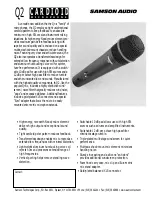
5
1. USB-C Port
Connect the USB-C
side of the included USB cable
to the microphone and the USB-A
side to the computer’s USB port.
2. Instrument / Line Input
Connect a
balanced or unbalanced instrument or
line-level signal using a 1/4" connector.
3. Instrument Knob
This knob adjusts
the input sensitivity of the instrument
input, allowing the signal to be adjusted
at an optimal level before it’s delivered
to the headphones.
4. Aux Input
Connect an 1/8" line-level
signal from a smartphone, MP3 player,
or other signal source.
5. Aux Knob
This knob adjusts the input
sensitivity of the aux input, allowing the
signal to be adjusted at an optimal level
before it’s delivered to the headphones.
6. Phones Jack
This 1/8" connector supplies the output
to stereo headphones.
7. Phones Knob
This knob is used to adjust the volume
at the phones output from off to max.
Make sure that this knob is fully off
[counter-clockwise] before beginning.
8. Blend Knob
This knob adjusts the mix
of the incoming computer (USB)
level (left) and the mic level (right)
to the headphones at zero-latency!
Knob position (L, C, R):
• Full Left
USB Input = Full Volume
Mic = No Volume
• Center
USB In and Mic = Equal Volume
• Full Right
USB Input = No Volume
Mic = Full Volume
9. Main Meters
Used to gauge the input
(left) and output (right) levels to ensure
that the signals are not clipping.
10. Pattern Knob
Polar patterns illustrate how sensitive
a microphone is to sound received via
different angles from the central axis.
Rotate the knob to the desired polar
pattern.
Bi-directional (figure 8):
Sound
is picked up from the front and rear
of the microphone, but not the sides.
Applications – Interviews, vocal duets,
instruments.
Cardioid:
The front of the microphone
is the most sensitive, while sound from
the surrounding area remains isolated.
Applications – Podcasts, voiceovers,
vocals, instruments.
Omni-directional:
Sound is picked up
equally from every direction, not needing
to be aimed directly at the sound source.
Applications – Conference calls /
meetings, field recordings, symphonies.
Stereo:
Sound is picked up from the left
and right sides of the microphone.
Applications – Field recordings, filming,
instruments.
11. Gain Knob
The gain knob adjusts the input
sensitivity of the microphone,
allowing signals from the outside
world to be adjusted at optimal levels.
12. Mute Switch
The mute switch does just what
it sounds like it might do. It mutes
the mic signal! The button illuminates
if the mute switch is engaged.
NOTE:
The mute switch mutes only
the mic input. Any signal coming IN
from the computer will still be heard
through the headphones regardless
of the state of the mute switch.
PATTERN
GAIN
24
L
R
INST
AUX
PHONES
BLEND
USB MIC
AUX
18
12
6
OL
INST
1
11
12
10
8
5
7
3
9 4
6
2
Summary of Contents for Chromium
Page 2: ...www mackie com ...
Page 19: ...www mackie com ...




































